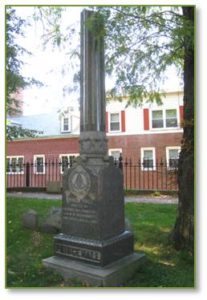Sometimes after I give a private tour for Boston By Foot I have a hour or so to check out a new place in the city or revisit one I have not been to in a long time. This week I led a private Dark Side of Boston tour in the morning and that gave me the opportunity to wander afterwards in Copp’s Hill Burying Ground. It seemed a good October Spookfest thing to do. Plus it gave me a great opportunity to work off the Regina’s Pizza I had for lunch.
I see this cemetery from the outside almost every week but then it’s usually after dark, when the gates are locked. So I enjoyed spending part of a gorgeous October afternoon wandering the paths at Copp’s Hill, reading the historical markers and finding the tombs or burial sites of people I talk about on Boston By Foot’s Dark Side tour.
History of Copp’s Hill
The Copp’s Hill Burying Ground was established in February of 1659 as the second cemetery in Boston after the one at King’s Chapel filled up. Subsequent acquisitions in 1711, 1809 and 1825 expanded it.
Located in Boston’s North End, it sits atop a rise formerly known as Windmill Hill for the windmill that once revolved atop it. The Burying Ground, which was originally named the North Burying Ground, later took on the name of shoemaker William Copp, who had once owned the land.
Part of Copp’s Hill itself was cut away in 1806, lowering it by 10 feet, to provide some of the fill for the old Mill Pond that later became known as the Bulfinch Triangle. Although the land-making process did not disturb the burying ground itself, it did create a steep retaining wall along Snow Hill Street where the ground was cut away. and the cemetery ends abruptly.
During the Revolutionary War, the British occupied Copp’s Hill. They placed batteries on the western slope of the hill between Hull and Snowhill Streets to fire on Bunker Hill. They also took potshots at some of the gravestones, which still bear the scars.
Famous Residents
Although Copp’s Hill cemetery encompasses only four acres, records tell us that between 10,000 and 11,000 burials took place here. Not all of those people remained in their “final” resting place, however.
Some were disinterred and moved to the new and more fashionable Mount Auburn Cemetery in Cambridge when it opened in 1831. There families could erect the kind of large tombs or impressive stones that simply would not fit in the Copp’s Hill site. Burying Ground officials moved other bodies to make room for more burials. Grave robbers also stole bodies for dissection at the Harvard Medical School.
Still on the hill you will find the graves of people who are famous—or notorious—for a variety of reasons. Among the many graves and tombs:
- The Reverend Doctors Increase Mather, Cotton Mather of the Second Church in Boston and a number of witchcraft trials. Also Samuel Mather, an independent minister.
- Robert Newman, patriot and sexton of Old North Church who hung the lanterns in the church steeple to tell Paul Revere and William Dawes which way the British Regulars were coming
- Edward Hartt, who built the U.S.S. Constitution, known as “Old Ironsides.” You get a good view of the oldest commissioned warship in the world from Hartt’s grave on Copp’s Hill
- Shem Drowne, coppersmith and maker of famous weathervanes including the grasshopper atop Faneuil Hall
- Prince Hall, founder of the Black Masons, now known as the Prince Hall Masons
- George Worthylake, first keeper of Boston Light in Boston Harbor
- More than 1,000 slaves and free African Americans from the New Guinea community once located at the bottom of Copp’s Hill
- John White Webster, executed for the murder of Dr. George Parkman and buried in an unmarked grave
- Captain Daniel Malcolm, a patriot whose gravestone is pockmarked by bullets.
October’s Bright Blue Weather
Tuesday afternoon was a glorious day filled with “October’s bright blue weather.” From the top of the hill a cloudless cerulean sky stretched overhead and sun lit up trees filled with yellow leaves so they glowed like lanterns. Many tourists prowled the burying ground with me and we took in the marvelous views of Charlestown, Old Ironsides, Boston Harbor, and the Zakim Bridge.
I can’t really consider Copp’s Hill Burying Ground as one of Boston’s Hidden Gems because it’s on the Freedom Trail just two blocks from the Old North Church, is visited by thousands of tourists and makes a popular stop on the city’s various ghost tours. I have passed by it at night many times, however, and the spookiest things I’ve ever seen are the costumed ghost-tour guides.
Copp’s Hill Burying Ground
 Hull & Snowhill Streets, Boston, MA
Hull & Snowhill Streets, Boston, MA
Entrance is on Hull Street
617.635.4505
cityofboston.gov
Nearest MBTA: North Station (Green & Orange Lines)
Walking Directions: Exit the station. Facing the TD Garden arena, walk to the right (east) down Causeway Street. Cross North Washington Street, there will be an old steel bridge on the left. Walk two blocks further east and take a right onto Hull Street. The burying ground is up the hill on the left. Alternatively, from Faneuil Hall, follow the Freedom Trail through the North End (about 25 minute walk).
Parking: Don’t even think about parking on Copp’s Hill or most streets in the North End. Trying to find a space will only waste time and make you frustrated. Use one of the lots scattered along Atlantic Avenue and Commercial Street and hike up.



